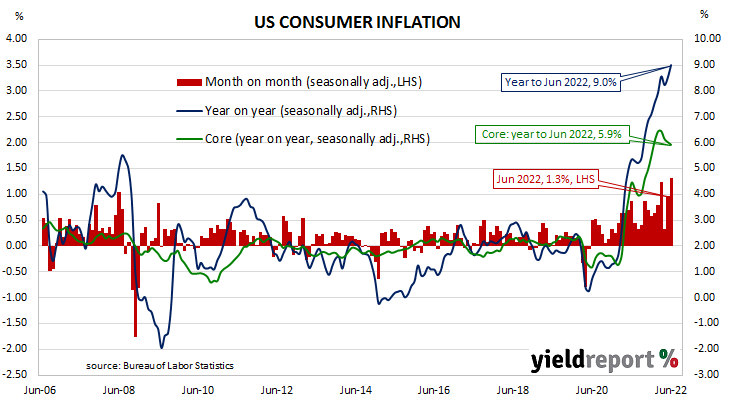Summary: US CPI up 1.3% in June, higher than expected; “core” rate up 0.7%; 9% “sticker shock”; short-term Treasury yields up, longer-term yields decline, rate rise expectations harden; energy prices main driver of headline rise; core service sector inflation “concerning”.
The annual rate of US inflation as measured by changes in the consumer price index (CPI) halved from nearly 3% in the period from July 2018 to February 2019. It then fluctuated in a range from 1.5% to 2.0% through 2019 before rising above 2.0% in the final months of that year. Substantially lower rates were reported from March 2020 to May 2020 and they remained below 2% until March 2021. Rates have since risen significantly.
The latest CPI figures released by the Bureau of Labor Statistics indicated seasonally-adjusted consumer prices rose by 1.3% on average in June. The increase was higher than the generally expected figure of 1.1% as well as May’s 1.0%. On a 12-month basis, the inflation rate accelerated from May’s reading of 8.5% to 9.0%.
“Headline” inflation is known to be volatile and so references are often made to “core” inflation for analytical purposes. The core prices index, the index which excludes the more variable food and energy components, increased by 0.7% on a seasonally-adjusted basis for the month. The rise was larger than the 0.5% expected as well as May’s 0.6% increase. However, the annual growth rate still slowed from 6.0% to 5.9%.
“There was nothing in the entrails of last night’s US CPI report to provide any offset to the sticker shock of headline CPI printing above 9%…” said NAB’s Head of FX Strategy within its FICC division Ray Attrill.
US short-term Treasury bond yields jumped on the day, while longer-term yields declined. By the close of business, the 2-year Treasury yield had gained 10bps to 3.15% while 10-year and 30-year yields both finished 3bps lower at 2.94% and 3.12% respectively.
In terms of US Fed policy, expectations of higher federal funds rates over the next 12 months hardened considerably. At the close of business, July contracts implied an effective federal funds rate of 1.70%, 12bps higher than the current spot rate. September contracts implied 2.715% while July 2023 futures contracts implied an effective federal funds rate of 3.19%, 161bps above the spot rate.
The largest influence on headline results is often the change in fuel prices. “Energy commodities”, the segment which contains vehicle fuels, increased by 10.4%, adding 0.54 percentage points. Prices of non-energy services, the segment which includes actual and implied rents, also had a significant effect, adding 0.40 percentage points after they increased by 0.7% on average.
“Most concerning here was the strength in core service sector inflation, in particular a 0.8% rise in primary actual rents and 0.7% rise in ‘owner-occupied’ rent…” added Attrill.



